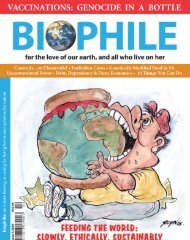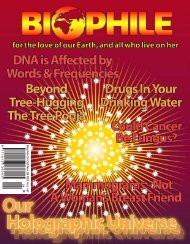BIOPHILE 16 â JUNE/JULY 2007 R25 - Biophile Magazine
BIOPHILE 16 â JUNE/JULY 2007 R25 - Biophile Magazine
BIOPHILE 16 â JUNE/JULY 2007 R25 - Biophile Magazine
- No tags were found...
Create successful ePaper yourself
Turn your PDF publications into a flip-book with our unique Google optimized e-Paper software.
Colloidal Silvera necessity for both good and bad timesby Robert C. Beck, D.Sc.You have food reserves to get youthrough an emergency. Some water.Probably some gold or silver. Maybesome defense weapons. But medicalhelp will probably be no more availablethan food, and under these conditions,disease and infections will probably berampant. Ordinary first aid supplies areobviously not enough.But there is good newsand its called “colloidalsilver”. From the time manfirst learned to work withsilver he has known thatit prevented the spread ofdisease. Thus the wealthypeople had silver drinkingcups, silver tableware andutensils.Even those who could have had gold,which does not tarnish, usually chosesilver because it promoted health. Inthe days before refrigeration, farmerstossed a silver coin in a bucket of milkto preserve it. Chemists put a silverdime in their petri dish to sterilize it.For hundreds of years it was commonpractice to place a silver wire in an infectedwound that refused to heal.Eventually man learned to makesilver nitrate and use it in wounds anddrink it as an antibiotic. But silver nitrateis caustic and burns tissues muchlike iodine. Also, heavy use of silver nitrateaccumulated in the skin turning itdark, a condition which became knownas Argyria. Still, it was an effectivetreatment of disease and that was moreimportant than ArgyriaIn the early 1900s research provedsilver to be effective against hundredsof pathogens of widely different kinds.Then it was found that smaller particlesof silver could be produced by precipitatingit out of chemical compounds ofsilver. These were more effective dueto the fact that there were hundreds oftimes as many particles of silver from agiven amount of silver.Eventually it was learned that silvercould be reduced down to its atomicsize with a positive electrical charge byusing an arc under water, producingthousands of particles for each one thatwas previously produced by the bestgrinding. It also added a positive chargewhich noticeably increased its effectiveness.Furthermore, no detrimental sideeffects have ever been shown. It did notcause argyria, even in prolonged largedosages. It was not caustic and insteadpromoted healing in general. No allergicreactions were ever reported. Itwas highly effective for most infectionsof every kind.It is is really important tobuy high quality colloidal silver(it should be a completely clearliquid) such as that producedby BioSil.Then came penicillin and sulfa,which could be patented and weretherefore well worth advertising. Thesewere soon followed by continuous newantibiotics from the pharmaceuticalcompanies. Each one is considered effectiveagainst certain pathogens, usuallyno more than half a dozen. Unlikesilver, almost none of the antibiotics iseffective against virus, yeasts or parasites.The chemical antibiotics do keep welland they are usually as effective afterlong storage as when first produced.This, plus the fact that they could bepatented, while silver could not, andtherefore the producers could afford topromote them heavily, have been majorfactors in the general adoption of theantibiotics.However, the antibiotics soon provedto have various side effects of varyingdegrees of danger. Some of the sideeffects are almost always experienced,while most only appear occasionally.But some of those occasional side effectsare as serious as death. There arethousands of patients a year who die ofan allergic reaction to penicillin, generallyconsidered to be among the safestand most proven antibiotic. A frighteningthing about this is that many ofthose deaths are to patients who havetaken penicillin many times in theirlife and were not aware of any problembefore.Soon after the new antibiotics wereintroduced it was found that certainbacteria they were effective againstdeveloped an immunity to the antibiotic.Some developed an immunity veryquickly, while others did so very slowly.Today many of the diseases that werethought to be easily treated by antibioticsare no longer treatable, even by newantibiotics. The researchers are runningout of new replacements, leaving thosediseases untreatable.These problems now have the wholemedical profession concerned, some tothe point of panic. The March 28, 1994issue of Newsweek featured a six pagearticle, “Antibiotics, The End of MiracleDrugs?”. The rise of drug resistantgerms is unparalleled in recorded history”,according to Newsweek. “Penicillinand tetracycline lost their powerover staph back in the 1950s and 60s. Abetter strategy might be to abandon antibioticsaltogether in favor of differentkinds of drugs.” How about abandoningdrugs altogether in favor of the naturalsilver?But Science Digest was way ahead ofNewsweek, in an article in March 1978;“Our Mightiest Germ Fighter”. ScienceDigest already saw the problem andhad the solution! In this article, JimPowell stated: “Thanks to eye openingresearch, silver is emerging as a wonderof modern medicine. An antibiotic killsperhaps half a dozen different diseaseorganisms, but silver kills some 650.Resistant strains fail to develop. Moreover,silver is virtually nontoxic.”The article further relates how Dr.Carl Moyer, Chairman of WashingtonState university’s Department ofSurgery, received a grant to developbetter treatments for serious burns. Dr.Harry Margraf was Dr. Moyer’s chiefbiochemist on this project. With theirstaff of medical researchers they tested22 antiseptic compounds and rejectedthem all. The problem was that infec-56 <strong>Biophile</strong> Issue <strong>16</strong>
















